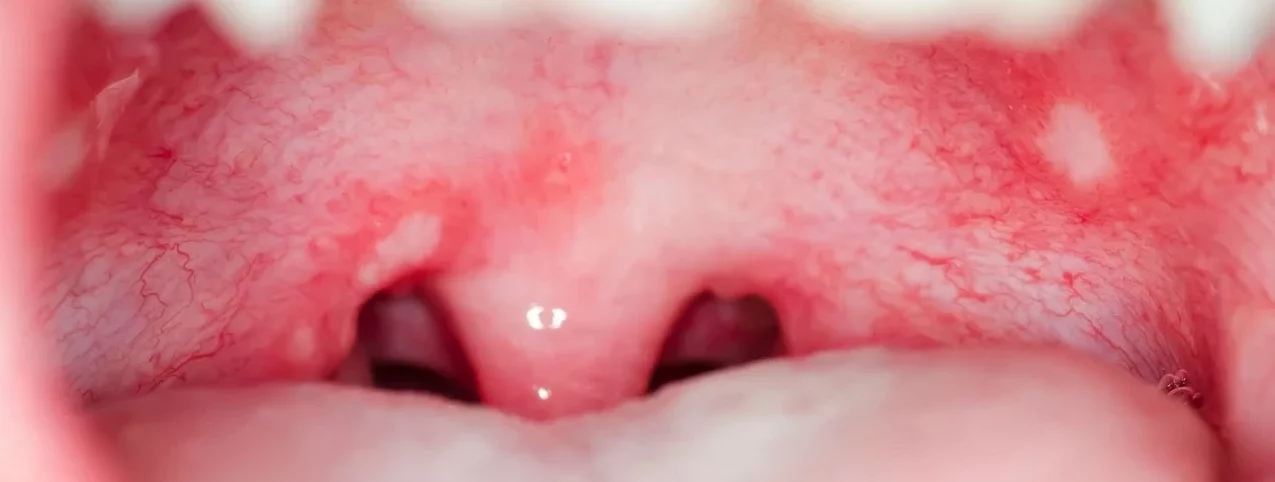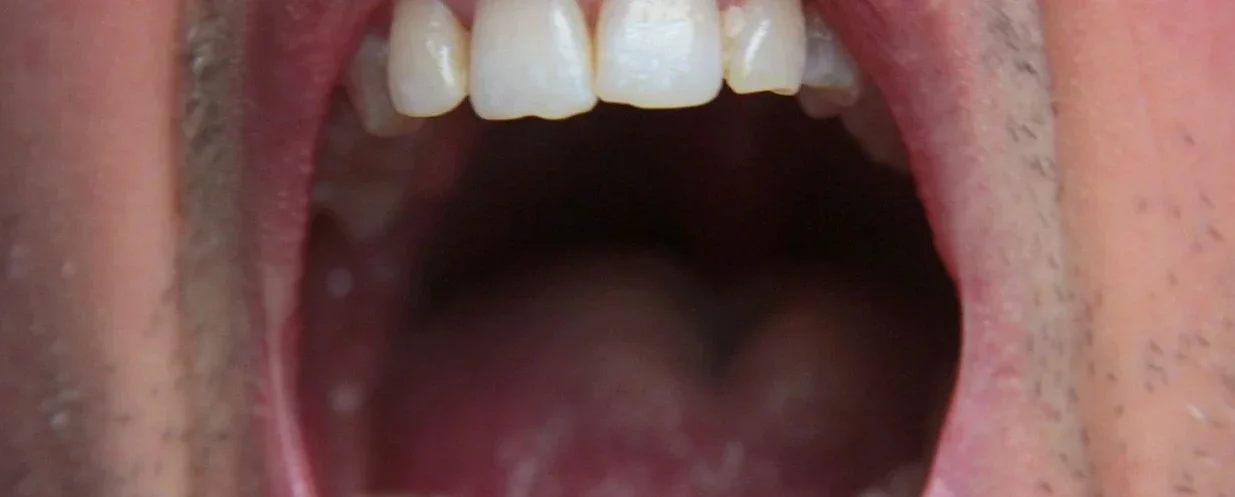It has been reported that approximately 20-30% of Americans have torus palatinus. It is more common in women from certain ethnic groups such as Asians, Europeans, and West Africans.
For any patient, knowing that they have a bump in their mouth can be distressing. The good news is that although they may sometimes cause discomfort, they usually do not represent a major cause for concern. Here, we will tell you more about this anomaly.
What is a Torus Palatinus?
A torus palatinus is a bony protrusion located on the roof of the mouth: on the middle part of the hard palate. It can have various shapes and sizes, so some are more prominent and noticeable than others. It is a benign (non-cancerous) anomaly that grows slowly. Some studies have shown that these protrusions are more common in women and people of Asian descent. It is not usually a reason for consultation in dentistry or medicine because the patient rarely perceives its presence as abnormal.
How is a Torus Palatinus present?
Torus palatinus can be observed as bumps or “lumps” on the roof of the mouth, generally covered by pink gums without color changes. They are hard in consistency, like bone. These lesions do not bleed or secrete fluids. They can present as a single form, although it is more common to find two joined, in a symmetrical and bilateral shape.
What are the Symptoms of a Torus Palatinus?
Generally, the formation of torus begins during puberty, although it can also start between the ages of 30 and 50. Then, they grow slowly, and they are usually first noticed in people over 30 years old. Oral tori do not hurt and rarely produce symptoms, so they are usually discovered incidentally during a routine clinical examination.
However, these are some of the signs and symptoms that may occur:
1. Feeling one or more hard bulges in the upper or roof of the mouth.
2. Pain-free protrusions in the upper part of the mouth.
3. Difficulty fitting orthodontic devices or mouthguards.
4. Impediments or changes in speech (when the torus is very large).
5. Difficulty properly fitting dentures to the roof of the mouth.
6. Difficulty swallowing if the torus is very large.
What is the Cause of a Torus Palatinus?
Although the cause of torus is not very clear, and there is not enough scientific evidence on the subject, it is believed that tori may be due to:
1. Genetic causes: It has been shown that they may be related to inheritance.
2. Age: Most people with this oral condition are over 30 years old.
3. Biomechanical causes: Overloading of forces on the maxillary bone, given by clenching or grinding of teeth, also known as bruxism.
4. Disorders of bone metabolism: Some researchers have found that they could be due to an increase in bone density.
5. Consumption of certain medications: It is believed that some antihypertensives may be related to the development of torus. However, the specific mechanism by which these drugs could induce the formation of torus is still unknown.
6. Disorders affecting the temporomandibular joint: Pathologies or dysfunction of the joint that connects the jaw to the skull.
Complications of Palatinus Torus
Presenting with this oral condition does not necessarily mean you have cancer or an infection, and it is not harmful or dangerous. However, when they grow too much or close to other bone structures, they can cause other types of discomfort:
• Depending on their location and size, they can cause discomfort while eating or chewing, as it is possible for food to get trapped in the growth area.
• Difficulty swallowing or passing food, especially in people who have growth at the back of the palate.
• Poor oral hygiene when the palatal torus grows near the teeth, makes brushing and flossing difficult, which over time is a risk due to the growth of plaque and tartar.
• It is possible to alter the movement of the tongue, which can negatively affect speech, causing discomfort and difficulty speaking. Depending on the size, it could even generate discomfort or a problem with closing the mouth.
Palatinus Torus Treatment: Should I have it Removed?
Generally, the palatal torus does not present complications, so it should only be removed in the following cases:
• If it has grown so much that it interferes with functions such as speech or chewing.
• If its large size makes it prone to constant lacerations or ulcers.
• If it prevents or interferes with the placement of a dental prosthesis.
• If it will be used as a bone graft donor to restore lost bone tissue in another area of the mouth, usually to replace missing teeth.
The diagnosis of this condition is usually visual, however, the dentist may refer to a computed tomography (CT) scan to ensure proper management, risks, and diagnosis.
This protrusion can be removed by oral surgeons, who remove the palatinus torus through a surgical procedure, which involves:
1. Sedation using local anesthesia or the method that the dentist deems most appropriate.
2. Then, an incision or cut is made in the gum or palate to expose the bone growth.
3. The excess bone is removed, and finally, it is closed with an incision using sutures.
During the surgical procedure, infection, bleeding, and inflammation that can last for several days may occur, and although it is rare, there is a possibility of an allergic reaction to anesthesia.
The growth of these protuberances is usually so slow and progressive that many times, patients do not even notice their presence. If this bone protrusion does not generate any symptoms or discomfort, no medical intervention is necessary.
Postoperative
Recovery from this intervention can take up to a month for complete closure. For a favorable and quick recovery, it is recommended that:
1. Follow the recommendations given by the dentist.
2. Take prescribed medications at the exact times.
3. Eat soft, mashed, or liquid foods. Avoid crunchy and hard foods.
4. Rinse frequently with an antibacterial mouthwash to keep the area clean.
When Should you Visit a Dentist?
If a patient has a bump on the roof of the mouth that has any of the following characteristics, it is recommended to seek dental consultation as soon as possible for proper diagnosis and treatment:
1. Painful bumps
2. Bumps with a soft or fluctuating consistency
3. Presence of secretions
4. Fever
5. Inflammation (redness of the gums and pain)
6. Ulcers on the palate or gums
7. Growths in other parts of the body
8. General discomfort or other symptoms throughout the body
Conclusion
Palatal tori are harmless and painless lesions that do not require removal if they do not cause discomfort or functional impairments.
If the patient has a bump on the palate with characteristics other than those mentioned or any of the warning signs described, they should seek a prompt medical or dental evaluation.
Share:
References
1. Loukas M, Hulsberg P, Tubbs RS, Kapos T, Wartmann CT, Shaffer K, Moxham BJ: The tori of the mouth and ear: A review. Clin Anat 2013; 26:953–60
2. Villines, Z. (2020, 8 abril). What is a torus palatinus? https://www.medicalnewstoday.com/articles/torus-palatinus
3. El Sergani, A. M., Anderton, J., Brandebura, S., Obniski, M., Ginart, M. T., Padilla, C., … & Weinberg, S. M. (2020). Prevalence of Torus Palatinus and association with dental arch shape in a multi-ethnic cohort. Homo: internationale Zeitschrift fur die vergleichende Forschung am Menschen, 71(4), 273.
4. Vaduganathan M, Marciscano AE, Olson KR. Torus palatinus. Proc (Bayl Univ Med Cent). 2014 Jul;27(3):259. doi:10.1080/08998280.2014.11929131. PMID: 24982582; PMCID: PMC4059586.
5. Che Ibrahim NH, Md Shukri N. Is it as dangerous as it looks? Malays Fam Physician. 2017 Apr 30;12(1):35-36. PMID: 28503274; PMCID: PMC5420323.
6. Aron, J., Raithel, S. J., & Mannes, A. J. (2017). Images in anesthesiology: Torus palatinus and airway management. Anesthesiology, 127(1), 164-164.
7. Cleveland Clinic. (reviewed on Mar 19, 2023). Torus Palatinus (Palatal Tori). https://my.clevelandclinic.org/health/diseases/24829-torus-palatinus
-
Nayibe Cubillos M. [Author]
Pharmaceutical Chemestry |Pharmaceutical Process Management | Pharmaceutical Care | Pharmaceutical Services Audit | Pharmaceutical Services Process Consulting | Content Project Manager | SEO Knowledge | Content Writer | Leadership | Scrum Master
View all posts
A healthcare writer with a solid background in pharmaceutical chemistry and a thorough understanding of Colombian regulatory processes and comprehensive sector management, she has significant experience coordinating and leading multidisciplina...


















